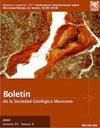First occurrence in life position of two Triassic brachiopod species (Thecideida) from NE Italy: Paleoecological considerations
IF 0.4
4区 地球科学
Q4 GEOLOGY
引用次数: 0
Abstract
The San Cassiano Formation from the Dolomites, NE Italy, is a Ladinian–Carnian (Middle – Upper Triassic) lithostratigraphic unit belonging to the Western Tethys domain. In this formation numerous groups of marine invertebrates from reef communities have been reported. In particular, brachiopods are represented by different orders. Thecideids are the most abundant and diverse, with different species of the genus Thecospira. Despite the apparent abundance, only one report exists of a thecideid of the genus preserved in life position: Thecospira tyrolensis. In this study, we describe and discuss the first finding of Thecospira semseyi and Thecospira tenuistriata in life position based on the study of thin sections of Cipit boulders. Seemingly, the Th. semseyi shells were not firmly attached to the substrate by a small cementation surface; therefore, they could have lived embedded into the biogenic matrix. By contrast, Th. tenuistriata displays an umbonal region modified in a cementation area, allowing the attachment to the bio-builder. Most samples don’t show any signal of transport since all specimens are articulated and are still attached to the substrate. Besides, the commissures are partially opened, free of any encrustation of sponge or bryozoan growing. The preservation of brachiopods suggests that the samples of both species were fossilized in life position. Moreover, Th. semseyi and Th. tenuistriata continued to live although the host’s fabric was imbibing the brachiopods’ ventral valve. This shows that thecideids were important components of Tethys reef communities.意大利东北部两种三叠纪腕足动物(脊鱼目)在生命位置上的首次出现:古生态学考虑
意大利东北部多洛米蒂地区的圣卡西亚诺组是一个Ladinian-Carnian(中-上三叠纪)岩石地层单元,属于西特提斯域。据报道,在该地层中,有许多来自珊瑚礁群落的海洋无脊椎动物。特别是腕足类动物有不同的目。苹果虫是最丰富和多样化的,有不同的种类的Thecospira属。尽管有明显的丰富性,但只有一份关于该属的一种被保存在生命位置上的化石的报告:tyrolensis锥皮蛛。在本研究中,我们描述并讨论了在Cibit巨石薄片研究的基础上首次发现的处于生命位置的Thecospira semseyi和Thecospia tenuistriata。看起来,Th.semseyi壳没有通过小的胶结表面牢固地附着在基底上;因此,它们可能生活在生物基质中。相比之下,Th.tenuistriata显示了一个在胶结区修饰的脐部区域,允许附着在生物构建剂上。大多数样本没有显示出任何运输信号,因为所有样本都是铰接的,并且仍然附着在基底上。此外,连合部分开放,没有任何海绵或苔藓虫生长的外壳。腕足类动物的保存表明,这两个物种的样本都是生命位置的化石。此外,尽管宿主的组织吸收了腕足动物的腹侧瓣膜,但Th.semyi和Th.ttenuistriata仍然存活。这表明该类是特提斯礁群落的重要组成部分。
本文章由计算机程序翻译,如有差异,请以英文原文为准。
求助全文
约1分钟内获得全文
求助全文
来源期刊
CiteScore
1.40
自引率
12.50%
发文量
34
审稿时长
50 weeks
期刊介绍:
The Boletín de la Sociedad Geológica Mexicana is a completely free-access electronic journal published semi-annually that publishes papers and technical notes with its main objective to contribute to an understanding of the geology of Mexico, of its neighbor areas, and of geologically similar areas anywhere on Earth’s crust. Geology has no boundaries so we may publish papers on any area of knowledge that is interesting to our readers.
We also favor the publication of papers on relatively unfamiliar subjects and objectives in mainstream journals, e.g., papers devoted to new methodologies or their improvement, and areas of knowledge that in the past had relatively little attention paid them in Mexican journals, such as urban geology, water management, environmental geology, and ore deposits, among others. Mexico is a land of volcanos, earthquakes, vast resources in minerals and petroleum, and a shortage of water. Consequently, these topics should certainly be of major interest to our readers, our Society, and society in general. Furthermore, the Boletín has been published since 1904; that makes it one of the oldest scientific journals currently active in Mexico and, most notably, its entire contents, from the first issue on, are available online.

 求助内容:
求助内容: 应助结果提醒方式:
应助结果提醒方式:


